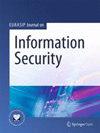基于模糊逻辑的无线传感器网络分层节能路由算法
IF 2.5
Q2 COMPUTER SCIENCE, INFORMATION SYSTEMS
引用次数: 0
摘要
目前,无线传感器网络中的传感器能量组装是有限的,聚类方法不能有效地提高传感器的能量消耗率。在此基础上,从剩余能量值、中心性和节点与基站之间的距离三个方面考虑,构建了一种基于模糊逻辑的分层节能路由算法。与低功耗自适应聚类分层协议算法、模糊不相等聚类算法和模糊逻辑簇头选举算法相比,模糊逻辑算法选择的剩余传感器节点具有更长的存活时间和更大的剩余能量。对于网络生命周期,研究第一个死节点出现的轮数由高到低:节能路由算法(400轮)>新的地理细胞结构算法(300轮)>基于虚拟网格的动态路线调整算法(100轮)。在同一实验轮下,节能路由算法的剩余能量曲线总是达到最大值。本研究所构建的基于模糊逻辑的节能路由算法能显著提高网络能源利用率,具有一定的参考价值。本文章由计算机程序翻译,如有差异,请以英文原文为准。
Hierarchical energy-saving routing algorithm using fuzzy logic in wireless sensor networks
Abstract Currently, sensor energy assembly in wireless sensor networks is limited, and clustering methods are not effective to improve sensor energy consumption rate. Thus, a hierarchical energy-saving routing algorithm based on fuzzy logic was constructed by considering three aspects: residual energy value, centrality, and distance value between nodes and base stations. The remaining sensor nodes selected by fuzzy logic algorithm have a longer time to live and greater residual energy than those selected by low-power adaptive clustering hierarchical protocol algorithm, fuzzy unequal clustering algorithm, and fuzzy logic cluster head election algorithm. For network life cycle, the number of rounds in which the first dead node appears, in descending order, is studied: energy-saving routing algorithm (400 rounds) > new geographic cellular structure algorithm (300 rounds) > virtual grid based dynamic routes adjustment algorithm (100 rounds). Under the same experimental round, energy-saving routing algorithm’s remaining energy curve always reaches its maximum. The energy-saving routing algorithm by fuzzy logic constructed by this research institute can significantly improve network energy utilization, which has certain reference value.
求助全文
通过发布文献求助,成功后即可免费获取论文全文。
去求助
来源期刊

EURASIP Journal on Information Security
COMPUTER SCIENCE, INFORMATION SYSTEMS-
CiteScore
8.80
自引率
0.00%
发文量
6
审稿时长
13 weeks
期刊介绍:
The overall goal of the EURASIP Journal on Information Security, sponsored by the European Association for Signal Processing (EURASIP), is to bring together researchers and practitioners dealing with the general field of information security, with a particular emphasis on the use of signal processing tools in adversarial environments. As such, it addresses all works whereby security is achieved through a combination of techniques from cryptography, computer security, machine learning and multimedia signal processing. Application domains lie, for example, in secure storage, retrieval and tracking of multimedia data, secure outsourcing of computations, forgery detection of multimedia data, or secure use of biometrics. The journal also welcomes survey papers that give the reader a gentle introduction to one of the topics covered as well as papers that report large-scale experimental evaluations of existing techniques. Pure cryptographic papers are outside the scope of the journal. Topics relevant to the journal include, but are not limited to: • Multimedia security primitives (such digital watermarking, perceptual hashing, multimedia authentictaion) • Steganography and Steganalysis • Fingerprinting and traitor tracing • Joint signal processing and encryption, signal processing in the encrypted domain, applied cryptography • Biometrics (fusion, multimodal biometrics, protocols, security issues) • Digital forensics • Multimedia signal processing approaches tailored towards adversarial environments • Machine learning in adversarial environments • Digital Rights Management • Network security (such as physical layer security, intrusion detection) • Hardware security, Physical Unclonable Functions • Privacy-Enhancing Technologies for multimedia data • Private data analysis, security in outsourced computations, cloud privacy
 求助内容:
求助内容: 应助结果提醒方式:
应助结果提醒方式:


